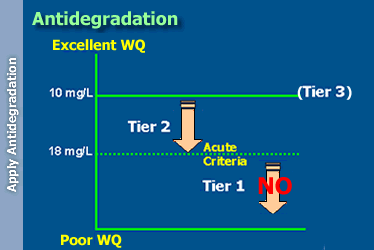

This slide attempts to summarize all the key provisions of antidegradation. In this hypothetical example, the chronic criterion for toxic pollutant "x" is 18 mg/L and the concentration of "x" in the waterbody is 10 mg/L. Since the ambient concentration of "x" is lower than the criterion concentration, antidegradation applies.
Rule/Tier 1 of antidegradation means that under no circumstances can the state, authorized tribe, or territory allow regulated activities to increase the level of "x" beyond the criterion (18 mg/L). Allowing levels of "x" to go beyond the criterion would result in impairment of the existing uses that the criterion is designed to protect. Hence, "Tier 1" appears to the right of the arrow with "NO" superimposed, in the area of the graph where concentrations of "x" would be greater than 18 mg/L.
The broken arrow going from the existing concentration (10 mg/L) to the criterion (18 mg/L) is meant to indicate Rule/Tier 2 of antidegradation. Lowering of water quality from high levels down to ones barely better than applicable criteria is not prohibited, but it can take place only in very limited circumstances.
Tier 3 appears to the right of the line corresponding to the existing level of "x" in the waterbody (10 mg/L), to indicate that for Tier 3-designated waters, virtually no degradation of water quality would be allowed. (Tier 3 is placed in parentheses as a reminder that Tier 3 applies only to specially designated waters.)